Cyprinidae
| Cyprinidae Temporal range:
| |
|---|---|

| |
| The common carp , Cyprinus carpio
| |
| Scientific classification | |
| Domain: | Eukaryota |
| Kingdom: | Animalia |
| Phylum: | Chordata |
| Class: | Actinopterygii |
| Order: | Cypriniformes |
| Superfamily: | Cyprinoidea
|
| Family: | Cyprinidae Rafinesque, 1815 |
| Type genus | |
| Cyprinus | |
| Subfamilies | |
and see text | |
Cyprinidae is a family of freshwater fish commonly called the carp or minnow family, including the carps, the true minnows, and their relatives the barbs and barbels, among others. Cyprinidae is the largest and most diverse fish family, and the largest vertebrate animal family overall, with about 3,000 species; only 1,270 of these remain extant, divided into about 200 valid genera.[1][2] Cyprinids range from about 12 mm (0.5 in) in size to the 3 m (9.8 ft) giant barb (Catlocarpio siamensis).[3] By genus and species count, the family makes up more than two-thirds of the ostariophysian order Cypriniformes.[1][2][4] The family name is derived from the Greek word kyprînos (κυπρῖνος 'carp').
Biology and ecology
Cyprinids are stomachless, or agastric, fish with toothless jaws. Even so, food can be effectively chewed by the
Hearing is a well-developed sense in the cyprinids since they have the
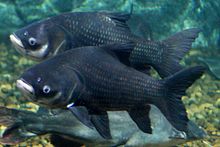
Cyprinids are native to
All fish in this family are egg-layers and most do not guard their eggs; however, a few species build nests and/or guard the eggs. The bitterlings of subfamily Acheilognathinae are notable for depositing their eggs in bivalve molluscs, where the young develop until able to fend for themselves.
Cyprinids contain the first and only known example of androgenesis in a vertebrate, in the
Most cyprinids feed mainly on
Some cyprinids, such as the
Unlike most fish species, cyprinids generally increase in abundance in
Relationship with humans

Food
Cyprinids are highly important food fish; they are
Sport
Cyprinids are popular for angling especially for
As pest control
Several cyprinids have been introduced to waters outside their natural ranges to provide food, sport, or biological control for some pest species. The common carp (Cyprinus carpio) and the grass carp (Ctenopharyngodon idella) are the most important of these, for example in Florida.
As a pest species
Carp in particular can stir up sediment, reducing the clarity of the water and making plant growth difficult.[12][13]
In America and Australia, such as the
Cyprinus carpio is a major pest species in Australia impacting freshwater environments, amenity, and the agricultural economy, devastating biodiversity by decimating native fish populations where they first became established as a major pest in the wild in the 1960s. In the major river system of eastern Australia, the Murray-Darling Basin, they constitute 80-90 per cent of fish biomass.[14]
In 2016 the federal government announced A$15.2 million to fund the National Carp Control Plan to investigate using
Aquarium fish
Numerous cyprinids have become popular and important within the aquarium and fishpond hobbies, most famously the goldfish, which was bred in China from the Prussian carp (Carassius (auratus) gibelio). First imported into Europe around 1728, it was originally much-fancied by the Chinese nobility as early as 1150 AD and, after it arrived there in 1502, also in Japan. In addition to the goldfish, the common carp was bred in Japan into the colorful ornamental variety known as koi — or more accurately nishikigoi (錦鯉), as koi (鯉) simply means "common carp" in Japanese — from the 18th century until today.
Other popular aquarium cyprinids include
One particular species of these small and undemanding danionines is the
Threatened families
Systematics
The massive diversity of cyprinids has so far made it difficult to resolve their
Part of the solution seems that the delicate rasborines are the core group, consisting of minor lineages that have not shifted far from their evolutionary niche, or have coevolved for millions of years. These are among the most basal lineages of living cyprinids. Other "rasborines" are apparently distributed across the diverse lineages of the family.[22]
The validity and circumscription of proposed subfamilies like the
The entirely
The
A DNA-based analysis of these fish places the Rasborinae as the basal lineage with the Cyprininae as a sister clade to the Leuciscinae.[25] The subfamilies Acheilognathinae, Gobioninae, and Leuciscinae are monophyletic.
Subfamilies and genera


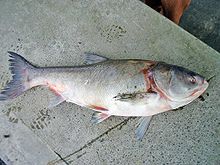
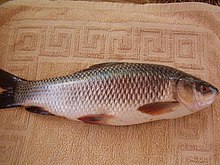

The 5th Edition of Fishes of the World sets out the following subfamilies:[26]

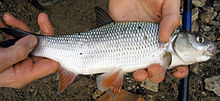
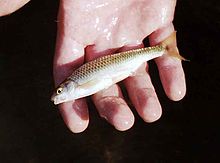
Subfamily Leuciscinae
|
|


Subfamily Squaliobarbinae
|
Subfamily Xenocyprinae
|
Incertae sedis
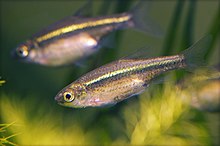
Possibly related to Aphyocypris.
|
|
With such a large and diverse family the taxonomy and phylogenies are always being worked on so alternative classifications are being created as new information is discovered, for example:[37]
Phylogeny
| Phylogeny of living Cyprinoidei[37][38] with clade names from van der Laan 2017.[39] | |||||||||||||||||||||||||||
|
Subfamily Probarbinae
- Catlocarpio
- Probarbus
Subfamily Labeoninae
- Tribe Parapsilorhynchini
- Diplocheilichthys
- Neorohita
- Parapsilorhynchus
- Longanalus
- Protolabeo
- Sinilabeo
- Tribe Labeonini
- Bangana
- Cirrhinus (mud carps)
- Decourus[40]
- Gymnostomus
- Incisilabeo
- Labeo (labeos)
- Speolabeo
- Schismatorhynchos
- Tribe Garrini
- Garra
- Paracrossocheilus
- Tariqilabeo
- Osteochilus clade
- Semilabeo clade
- Ageneiogarra
- Altigena[40]
- Cophecheilus
- Discogobio
- Hongshuia
- Linichthys
- Mekongina
- Paraqianlabeo [32]
- Parasinilabeo
- Placocheilus
- Prolixicheilus
- Pseudocrossocheilus
- Pseudogyrinocheilus
- Ptychidio
- Qianlabeo
- Rectoris
- Semilabeo
- Sinigarra [41]
- Sinocrossocheilus
- Stenorynchoacrum [34]
Subfamily Torinae
- Tribe Torini[42]
- Arabibarbus [43]
- Carasobarbus
- Labeobarbus (yellowfish)
- Mesopotamichthys
- Pterocapoeta
|
|
Subfamily Smiliogastrinae
- Tribe Smiliogastrini[44]
- Amatolacypris
- Cheilobarbus
- Enteromius (African barbs)
- Namaquacypris
- Pseudobarbus (redfins)
- Sedercypris (Cedarberg redfins)
|
|
Subfamily Cyprininae [incl. Barbinae]
Subfamily
|
|
Subfamily





Subfamily Xenocypridinae [incl. Cultrinae & Squaliobarbinae]
|
|
Subfamily Tincinae
Subfamily
- ?Acanthorhodeus(Khanka spiny bitterling)
- Acheilognathus
- Paratanakia
- Pseudorhodeus
- Rhodeus
- Tanakia
Subfamily Gobioninae
|
|
Subfamily
Subfamily Leuciscinae [incl. Alburninae]
|
|
Incertae sedis

Possibly related to Aphyocypris.
|
|
See also
References
- ^ a b Froese, Rainer, and Daniel Pauly, eds. (2015). "Cyprinidae" in FishBase. July 2015 version.
- ^ a b Eschmeyer, William N.; Fricke, Ron & van der Laan, Richard (eds.). "Genera in the family Cyprinidae". Catalog of Fishes. California Academy of Sciences. Retrieved 2 July 2015.
- ^ a b Froese, Rainer; Pauly, Daniel (eds.) (2015). "Catlocarpio siamensis" in FishBase. March 2015 version.
- ISBN 0-471-25031-7.
- ^ Froese, Rainer; Pauly, Daniel (eds.) (2017). "Tor putitora" in FishBase. March 2017 version.
- ^ Froese, Rainer; Pauly, Daniel (eds.) (2017). "Luciobarbus esocinus" in FishBase. March 2017 version.
- ^ Froese, Rainer; Pauly, Daniel (eds.) (2015). "Ptychocheilus lucius" in FishBase. March 2015 version.
- ^ Froese, Rainer; Pauly, Daniel (eds.) (2015). "Paedocypris progenetica" in FishBase. March 2015 version.
- PMID 28573029.
- ^ Based on data sourced from the FishStat database
- ^ MacMahon, Alexander Francis Magri (1946). Fishlore: British Freshwater Fishes. Pelican Books. Vol. 161. Penguin Books. pp. 149–152.
- ^ Gulf States Marine Fisheries Commission (3 August 2005). "Cyprinus carpio (Linnaeus, 1758)". Archived from the original on 18 August 2007. Retrieved 3 May 2007.
- ^ Florida Fish and Wildlife Conservation Commission (2006). "Exotic Freshwater Fishes". Archived from the original on 8 February 2007. Retrieved 5 March 2007.
- S2CID 249222934.
- S2CID 244518717.
- ^ Kilvert, Nick; Thomas, Kerrin (1 May 2016). "Herpes virus to be used in fight against carp in Murray River, Christopher Pyne says". ABC News. Australian Broadcasting Corporation. Archived from the original on 5 May 2016.
- ^ "Carp herpesvirus". Managing Water Ecosystems - CSIRO. 2018-04-26. Retrieved 2020-11-09.
- ISSN 0021-8901.
- ^ Riehl, R.; Baensch, H. (1996). Aquarium Atlas Volume 1. Voyageur Press. p. 410.
- OCLC 299475257.
- ^ .
- ^ (PDF) from the original on 2011-08-11.
- ^ (PDF) from the original on 2020-07-29.
- ^ Howes, G.I. (1991). "Systematics and biogeography: an overview". In Winfield, I.J.; Nelson, J.S. (eds.). Biology of Cyprinids. London: Chapman and Hall Ltd. pp. 1–33.
- PMID 23044401. Archived from the originalon 2020-06-08. Retrieved 2019-12-07.
- ISBN 978-1-118-34233-6. Archived from the originalon 2019-04-08. Retrieved 2019-09-05.
- ^ ISSN 0936-9902.
- ^ a b c d e f g h Kottelat, M. (2013). "The Fishes of the Inland Waters of Southeast Asia: A Catalogue and Core Bibliography of the Fishes Known to Occur in Freshwaters, Mangroves and Estuaries" (PDF). The Raffles Bulletin of Zoology (Supplement No. 27): 1–663. Archived from the original (PDF) on 2 December 2013.
- PMID 26213759.
- ^ PMID 18757732.
- ^ a b Britz, Ralf; Kottelat, Maurice; Tan, Heok (1 December 2011). "Fangfangia spinicleithralis, a new genus and species of miniature cyprinid fish from the peat swamp forests of Borneo (Teleostei: Cyprinidae)". Ichthyological Exploration of Freshwaters. 22 (4): 327–335.
- ^ PMID 25082039.
- S2CID 2027617.
- ^ PMID 24870177.
- .
- ^ PMID 25082046.
- ^ PMID 28683774.
- PMID 25698355. Archived from the originalon 2021-03-06. Retrieved 2019-12-07.
- ISSN 2468-9157.
- ^ S2CID 190878336.
- S2CID 2027617.
- PMID 28264326.
- S2CID 14947417.
- PMC 6204829.
- PMID 26213759.
- S2CID 28572859.
External links
![]() Media related to Cyprinidae at Wikimedia Commons
Media related to Cyprinidae at Wikimedia Commons
![]() Data related to Cyprinidae at Wikispecies
Data related to Cyprinidae at Wikispecies

